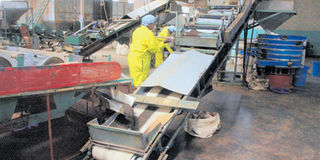10 things to consider when setting up a value addition business

A factory worker inspects tea production at Iriaini Factory in Nyeri. PHOTO | FILE | NATION MEDIA
What you need to know:
- Avoid areas prone to flooding, those infested with pests and where wastes cannot be removed effectively.
- Where appropriate, critical limits established in Hazard Analysis and Critical Control Points (HACCP) based plans can be monitored.
- Sufficient water supply with appropriate facilities for storage, distribution and temperature control should be available.
- Where necessary, appropriate records of processing, production and distribution should be kept and retained for a period that exceeds the shelf-life of the product.
1. LOCATION AND PRODUCTION SITE
This is where the production activity is performed, from the reception and conservation of raw materials, to the storage of finished products.
Food processing plants should not be located where it is clear that there will be a threat to food safety.
That is, the plants should be sited away from environmentally polluted areas, which can contaminate the final product.
Avoid areas that are prone to flooding, those infested with pests and where wastes, either solid or liquid, cannot be removed effectively.
2. EQUIPMENT
Equipment and containers come into contact with food.
They should, therefore, be designed and constructed to ensure that where necessary, they can be adequately cleaned and disinfected to avoid the contamination of food.
In addition, equipment used to cook, heat treat, cool, store or freeze food should be designed to achieve the required food temperatures as rapidly as necessary in the interests of food safety and effective maintenance.
These requirements are intended to ensure that harmful or undesirable micro-organisms or their toxins are eliminated or reduced to safe levels or their survival and growth are effectively controlled.
Also where appropriate, critical limits established in Hazard Analysis and Critical Control Points (HACCP) based plans can be monitored and temperatures and other conditions necessary to food safety be rapidly achieved and maintained.
3. WATER SUPPLY, DRAINAGE AND WASTE DISPOSAL
Sufficient water supply with appropriate facilities for storage, distribution and temperature control should be available to guarantee safety and high standards of hygiene.
Suitable drainage and waste disposal systems and facilities should be provided. They should be designed to ensure the risk of contaminating food is avoided.
4. CLEANING, HYGENE FACILITIES AND TOILETS
Ample facilities should be provided for cleaning food, utensils and equipment.
Such facilities should have an adequate supply of hot and cold water where appropriate.
Personnel hygiene facilities should be available to ensure that an appropriate degree of sanitation is maintained.
5. TEMPERATURE CONTROL
Depending on the nature of the food operations undertaken, adequate facilities should be available for heating, cooling, cooking, refrigerating and freezing, for storing refrigerated or frozen foods, monitoring food temperatures, and when necessary, controlling ambient temperatures to ensure the safety and suitability of the final product.
6. AIR QUALITY AND VENTILATION
Suitable means of natural or mechanical ventilation should be provided to minimise:
- Air-borne contamination of food, for example, from aerosols and condensation droplets.
- Control ambient temperatures.
- Control odours, which might affect the suitability of food.
- Control humidity.
Ventilation systems should be constructed so that air does not flow from contaminated areas to clean areas and, where necessary, they can be adequately maintained and cleaned.
7. LIGHTING
Provide natural or artificial lighting to operate in a hygienic manner. Lighting fixtures should, where appropriate, be protected to ensure that food is not contaminated by breakages.
8. STORAGE
Where essential, acceptable facilities for the storage of food, ingredients and non-food chemicals (for cleaning materials, lubricants and fuels) should be supplied.
Food storage facilities should be designed and constructed to permit adequate maintenance and cleaning, avoid pest access and harbourage, enable food to be effectively protected from contamination during storage and where necessary, provide an environment which minimises the deterioration of food due to high temperature and humidity control.
The type of storage facilities required will depend on the nature of the food.
9. CONTROL HAZARDS
Control food hazards through the use of HACCP, which involves identification of steps in plant’s operations, which are critical to the safety of food.
This is followed by implementation of effective control procedures; monitoring control procedures to ensure their continuing effectiveness; and review control procedures periodically, and whenever the operations change.
These systems should be applied during the food chain to control hygiene in the shelf-life of the product.
Where necessary, appropriate records of processing, production and distribution should be kept and retained for a period that exceeds the shelf-life of the product.
Documentation can enhance the credibility and effectiveness of the food safety control system.
10. PRODUCTION INFORMATION AND LOT IDENTIFICATION
All food products should be accompanied by or bear adequate information to enable the next person in the food chain to handle, display, store and prepare and use safely and correctly.
Lot identification is critical in product recall and helps effective stock rotation.
Each container of food should be permanently marked to identify the producer and the lot.
***
Ms Mutua works in the Department of Dairy, Food Science and Technology, Egerton University.




